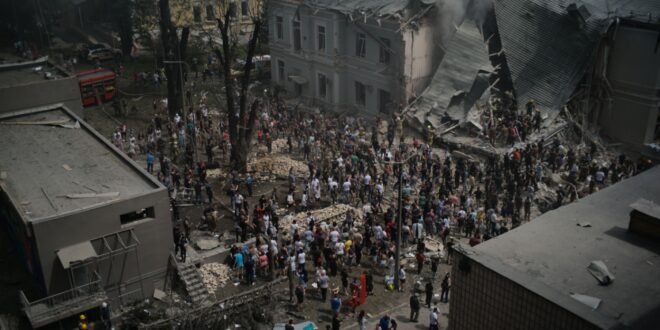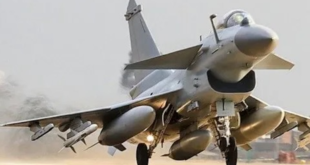After Russia fired a record number of missiles at Ukraine on August 26, it became obvious: despite all the sanctions, the Russian Armed Forces manage to produce new missiles at a pace that allows for regular massive shelling, and the percentage of missiles shot down has decreased, and their accuracy has increased. Under these conditions, the Kremlin returned to the seemingly failed plan to arrange a humanitarian catastrophe in Ukraine by destroying its energy system. According to experts, in order for Ukraine to be able to defend itself, many measures are needed at once, including a significant increase in the number of Patriot-type anti-aircraft missile systems supplied to Ukraine, the strengthening of the sanctions regime, bypassing which the supply of components continues, and the lifting of the remaining bans limiting long-range missile strikes on the carriers of these missiles, including their bases and military airfields.
Missile threat
On the night and during the first half of the day on August 26, the territory of Ukraine was subjected to the most massive air raid during the war. A total of 236 missiles and drones were used, the geography of the attack covered 15 Ukrainian regions, critical infrastructure facilities were hit, and emergency power outages were introduced throughout the country. In total, seven people became victims, another 47 were injured.
This strike is not only another episode of the Kremlin regime’s war against the civilian population of Ukraine, but also a clear confirmation that in the third year of the war, the Russian missile threat still hangs over Ukrainian cities. No one is immune to shelling, not even residents of the tightly covered air defense of Kyiv, where on July 8, two people were killed and 32 more were injured as a result of a Russian missile strike on a children’s hospital.
Rocket attacks have remained an important element of Russian aggression since the beginning of the full-scale invasion, despite regular statements by the Main Intelligence Directorate that the stocks of long-range fire weapons are about to run out. According to the Commander-in-Chief of the Armed Forces of Ukraine Alexander Syrsky, as of August 20, 2024, a total of 9627 missiles have been launched on the territory of Ukraine since February 24, 2022, of which only 2429 were intercepted.
Since February 24, 2022, 9627 missiles have been launched on the territory of Ukraine, of which only 2429 were intercepted
Missile invasion
On the eve of the full-scale invasion of Ukraine, the Russian Armed Forces had an impressive number of missiles of various types (hereinafter only missiles equipped with a non-nuclear warhead are considered, although most of them can also carry nuclear warheads). Strategic aviation was equipped with long-range subsonic cruise missiles, as well as supersonic ones. Front-line aviation, in turn, carried Kh-35, Kh-38 and Kh-59 missiles. Finally, in the arsenal of the Russian Aerospace Forces there was a “secret weapon” – Kinzhal missiles, which propaganda positioned as hypersonic.
The fleet had many carriers of Kalibr cruise missiles, and the coastal troops had Onyx anti-ship missiles capable of striking ground targets. Missile brigades of the ground forces have completed re-equipment at the Iskander OTRK, launching both cruise and ballistic missiles.
The beginning of the Russian full-scale invasion on February 24 was accompanied by a massive missile raid throughout Ukraine – according to the US Department of Defense, 160 missiles were launched on the first day alone. The main targets were airfields and positions of Ukrainian air defense systems. Part of the aviation and air defense systems was removed from the attack, but a significant part of the anti-aircraft systems was destroyed on the first day.
However, soon the Ukrainian air defense restored control, after which the Russian Aerospace Forces had to curtail such operations due to significant losses. Missiles (along with the few Orion-type attack UAVs and Kub loitering ammunition) remained almost the only means of striking the Ukrainian operational and strategic rear.
According to the Pentagon, by the end of March 2022, the total number of missiles launched reached 1200 units. It is noteworthy that the Iskander were used for their intended purpose, namely to support the advancing groups of troops. An example is the strike on a battery of Ukrainian heavy self-propelled guns “Pion” near Kyiv.
At first, the Iskander was used for its intended purpose, namely to support the advancing groups of troops
However, apparently, soon the stocks of missiles became insufficient or the number of combat-ready systems turned out to be insufficient, and the previous generation Tochka-U missile systems were added to the Iskanders – a strike with such a missile on the railway station in Kramatorsk claimed the lives of 61 people.
In general, Russian missile strikes were not particularly systematic. For example, for unknown reasons, the RF Armed Forces fired missiles at TV towers in Kyiv, Rivne and Vinnytsia. Further, the shelling switched to oil depots (1, 2), and then to railway traction substations (1, 2), but it was not possible to cause a large-scale fuel crisis or disrupt rail transportation.
At the same time, some strikes were extremely effective – for example, on the Yavoriv training ground, on the barracks in Mykolaiv and on the training center in Desna in the Chernihiv region. According to one of the Ukrainian estimates, by the beginning of May 2022, up to 40% of the pre-war number of Iskander and Kalibr missiles remained in Russian arsenals. Obviously, the remaining reserves needed to be put to better use.
Missile genocide
On October 10, 2022, the most massive single missile attack on Ukraine at that time took place. According to the General Staff of the Armed Forces of Ukraine, a total of 84 missiles were launched, as well as 24 drones, including 13 Shahed missiles that recently entered service. The Ukrainian military announced 43 downed missiles and 13 drones. Critical and civilian infrastructure facilities in 12 regions and Kyiv were hit, 19 people were killed, another 105 were injured. Many settlements were left without electricity as a result of the destruction of thermal power plants and power substations, the government urged the population to save electricity.
This and subsequent strikes were associated with the appointment of Sergei Surovikin to the post of commander of the United Group of Forces. While still the commander of the Russian group in Syria, he applied a strategy of destroying the infrastructure of areas controlled by the opposition. The targets of the Russian Aerospace Forces were schools, hospitals, humanitarian aid points, bakeries, markets, and the headquarters of the Syrian Civil Defense (White Helmets). Thus, life in these territories became unbearable, which increased the flow of refugees and destroyed the social base of the anti-Assad forces. The strategy bore fruit: by 2020, only areas that were under the protection of other external players, namely Turkey and the United States, remained uncontrolled by Damascus.
The targets of the Russian Aerospace Forces were schools, hospitals, humanitarian aid points, bakeries, and markets
Apparently, a similar strategy was chosen for Ukraine. However, if in Syria the Russian Aerospace Forces acted with impunity due to the lack of air defense systems in the opposition, then when planning the bombing of Ukraine, they had to stop at a limited set of the most significant targets.
The choice fell on the energy infrastructure, which consisted of fairly large and, apparently, well-known facilities to the Russian command. In addition, it was assumed that on the eve of the heating season, the disruption of power supply would hit the civilian population, causing a new migration crisis and undermining the economic base of the Ukrainian state. The possible death of many people in freezing high-rise buildings was apparently considered “collateral damage.”
From October 2022 to March 2023, massive rocket attacks on Ukraine were repeated more than 10 times. The first of them turned out to be so destructive that the Ukrainian capital was on the verge of a complete evacuation of the population. Residents of Kyiv, the Kyiv region and Odessa had to survive without electricity and heating for many hours and even days.
In order to preserve and restore the energy system of Ukraine, Western partners have created an “energy Ramstein” – a consultative group similar to the one created earlier to coordinate the supply of weapons. In addition, then for the first time they started talking about Ukraine receiving modern air defense systems, in particular the Patriot air defense system. However, they did not have time to participate in repelling the first wave of attacks on the energy system of Ukraine – the last massive shelling of the winter campaign took place on March 9, 2023, when 81 missiles were fired at Ukraine, 34 of which were shot down.
Rocket Duel
By the spring of 2023, it became obvious that the Russian missile campaign had failed. According to the Main Intelligence Directorate, by this time, the pre-war stocks of Russian missiles had finally been exhausted, but new production increased significantly, despite the sanctions. In May 2023, Ukrainian intelligence believed that Russia was producing 25 Kalibrs, 35 Kh-101s, five 9M723 ballistic missiles for the Iskander-M OTRK and two Kinzhals per month. The Russian command pinned special hopes on the latter, but soon the situation changed with the arrival of the long-awaited Patriots in Ukraine.
Deputy Defense Minister Oleksandr Pavlyuk announced the arrival of these complexes in Ukraine on April 19, 2023, and already in early May, the Ukrainians managed to shoot down the Kinzhal (the type of missile was confirmed by comparing photos of the wreckage with the missile that had previously fallen in the Stavropol Territory).
On May 16, the Air Force of the Armed Forces of Ukraine reported on the downing of six Kinzhals at once. Obviously, their target was the Patriot installations stationed in Kyiv, one of which even managed to be damaged, but the damage was minor and was repaired on the spot.
The confrontation between Russian missiles and Ukrainian missiles did not end there. The Armed Forces of Ukraine built a layered air defense system around the Patriot, NASAMS, IRIS-T, Hawk, Crotale and other air defense systems, as well as Soviet systems that were converted to use Western anti-aircraft missiles as part of the FrankenSAM project.
Russia, in turn, improved its own missiles – for example, the Kh-101 first increased the warhead by reducing the range, and then added another one with an additional damaging effect. In addition, supersonic anti-ship Kh-22s were widely used, which, despite the low accuracy of guidance on ground targets, were invulnerable to most of the air defense systems available to the Armed Forces of Ukraine due to their high speed.
In addition, the Kremlin replenished missile stocks with the help of allies. At the beginning of 2024, along with North Korean artillery ammunition, KN-23 ballistic missiles began to be used, the wreckage of which was regularly found in Kharkiv (1, 2). However, subsequently, their use was temporarily stopped and resumed only in the summer, which may be explained by the insufficient rate of production of these missiles in the DPRK.
At the same time, the Kimskanders are not reliable – according to the Office of the Prosecutor General of Ukraine, about half of the missiles deviated from the course or exploded in the air. In addition, Reuters sources spoke about the supply of missiles from Iran as a fait accompli, but they were never seen on the battlefield.
In turn, the Armed Forces of Ukraine received the first of the long-awaited ATACMS missiles from the United States, demonstrating their effectiveness by striking the airfields based on Russian helicopters in occupied Berdyansk and Luhansk. However, the missiles were delivered too late to have a serious effect on the course of the Ukrainian counteroffensive in 2023. Nevertheless, it seemed that a certain missile parity had come to the war – until Russia launched new strikes.
The ATACMS missiles were delivered too late to have a serious effect on the course of the 2023 Ukrainian counteroffensive
Missile superiority
In the winter of 2023-2024, Russian missile strikes were apparently aimed at disrupting the work of the Ukrainian military-industrial complex. It is difficult to judge how much these strikes affected the work of the Ukrainian defense industry, but by April 2024, according to Volodymyr Zelenskyy, it was possible to reach the production of, for example, 10 units of 155-mm self-propelled guns “Bogdan” per month. According to Serhiy “Flash” Beskrestnov, after the failures, the Russians changed tactics, seeking to de-energize Ukrainian enterprises with new missile strikes on energy infrastructure.
As it was thought, the Ukrainian energy sector was ready for new attacks, however, compared to the 2022-2023 campaign, the Russian approach has changed significantly. If then the strikes were carried out mainly on distribution substations in an attempt to disrupt the connectivity of the energy system of Ukraine, now the main target has become power generation facilities, in particular thermal power plants and hydroelectric power plants.
This was partly due to the fact that Russian forces could no longer afford the same scale and frequency of rocket attacks – if in 2022-2023 more than 100 missiles could be launched simultaneously on the territory of Ukraine, then, for example, during the shelling on July 8, 2024, their number was estimated as “more than 40”. It took more than a month and a half from July 8 to accumulate 127 missiles for a record strike on August 26, 2024.
The Soviet-era power plants are relatively easy targets: they are large facilities whose location and design are well known. Therefore, it was possible to disable a significant part of Ukrainian electricity generation (which could have potentially serious consequences) with a smaller number of air weapons.
In addition, Russia continued to improve missile weapons, using, in particular, stealthy Kh-69s. However, the use of other missiles, in particular the full-fledged hypersonic Zircons, was unsuccessful.
At the same time, the effectiveness of the interception of Russian missiles by Ukrainian air defense systems decreased, which was due to both the depletion of stocks of missiles against the backdrop of delays in American military assistance, and an increase in the share of ballistic missiles used by the Russian Armed Forces.
According to Syrsky’s data above, the interception rate for Iskander-M/KN-23 ballistic missiles is 4.3% (56 out of 1,300 launched), and for aeroballistic Kinzhals it is 25% (28 out of 111), while for Kalibr sea-launched cruise missiles this figure is 49.5% (443 out of 894), and for Kh-555/Kh-101 air-launched cruise missiles it is 78% (1440 out of 1846).
The effectiveness of the interception of Russian missiles by Ukrainian air defense systems has decreased
In addition, due to the active use of reconnaissance UAVs capable of flying into the Ukrainian rear at a distance of more than 100 km, the accuracy of the use of ballistic missiles has increased. The Russian side managed to hit such valuable samples of military equipment as the HIMARS MLRS and the Patriot air defense system. In addition, strikes on Ukrainian airfields dozens and even more than 100 km from the front line were much more successful.
Ukrainian forces did not remain in debt, hitting air defense positions in the occupied territories, in particular in Crimea, with newly arrived long-range ATACMS missiles (1, 2, 3). However, until now, the current ban on the use of such missiles on the internationally recognized territory of Russia significantly limits Ukraine’s capabilities in the growing missile confrontation, acting in fact as one of the factors of superiority of the RF Armed Forces.
Missile prospects
Russia manages to increase the production of long-range missiles. According to the GUR, 50 units per month roll off the assembly line, which should be enough for 1-2 large shelling by today’s standards, and according to the Financial Times, the production of Kh-101 cruise missiles is 8 times higher than pre-war figures.
In January 2024, the Main Intelligence Directorate estimated Russia’s monthly production at 115-130 “strategic” missiles (both cruise and ballistic), as well as 100-115 operational-tactical missiles such as the Kh-31 and Kh-59, which are used, in particular, to strike at Ukrainian air defense systems.
Such indicators can be achieved thanks to the ongoing import of sanctioned components. The New York Times reported on the discovery of American components in a missile that hit the Okhmatdyt children’s hospital in Kyiv. According to the report of the Yermak-McFaul group engaged in sanctions policy, 46 foreign components were counted in the Kinzhal missile.
The Insider has repeatedly covered ways and methods to circumvent sanctions to ensure Russian missile production (1, 2, 3). As long as the sanctions policy of Western countries is catching up, the missile threat to Ukraine will not disappear, even if all Kyiv’s requests for air defense supplies are met – and this is still a long way off.
American components were found in the missile that hit the Okhmatdyt children’s hospital in Kyiv
In a conversation with The Insider, John Hardy, deputy director of the Russian program at the Foundation for Defense of Democracies, stressed that the United States and Western allies could more effectively monitor compliance with sanctions norms, but it is impossible to completely stop supplies:
“Russia has largely managed to circumvent Western controls on the export of microelectronics and other military components, although in some cases it has probably had to overpay or settle for lower quality. Many of these shipments go through China and other “friendly countries.” The U.S. government and other Western states could probably be more effective in enforcing sanctions and export controls, but ultimately I doubt that we will be able to completely stop the supply of these components to Russia.”
According to Volodymyr Zelenskyy, in order to completely close the Ukrainian sky from Russian missiles and aircraft, 25 Patriot air defense systems or their analogues are needed. The minimum number required to cover key cities is seven complexes.
At the NATO summit in Washington, Ukraine was promised four Patriot systems and one SAMP-T, but most partner countries, with the exception of Germany, are in no hurry to deliver the promised deliveries. But even with the necessary air defense systems in place, Ukraine may face a shortage of missiles for them – currently, only 500 PAC-3 anti-ballistic missiles are produced worldwide per year, and plans to increase this number to 750 are hampered by a lack of guidance heads (new production lines will not enter service until 2027). Therefore, the aviation of the Armed Forces of Ukraine has to perform the air defense function, shooting down Russian missiles and drones during shelling, which, as far as we can tell, has already led to the loss of the first Ukrainian F-16.
Ukrainian air defense lacks not only Western air defense systems, but also missiles for them
Another effective way to combat shelling is strikes on carriers on the ground, at airfields and at bases. The Insider columnist Colby Badvor describes this strategy as “shooting archers, not arrows” and is outraged that the United States and other Western partners have not yet lifted the ban on long-range missile strikes on Russian territory. Missile weapons expert Jeffrey Lewis echoed him, noting that the low percentage of ballistic missile interception shows that “shooting archers” would be more effective.
Norwegian military expert Tor Are Iversen, in a comment for The Insider, points out that it is impossible in principle to fully protect the Ukrainian sky:
“The problem is that Ukraine is a big country, and since the missiles for the S-300 are running out, there are simply not enough Western systems to replace them one by one, even in the most favorable scenario <… > the West is experiencing difficulties in increasing production. That is why strikes outside Kyiv often cause more damage than strikes on the capital, and there will always be gaps that the Russians can exploit. Where to deploy their air defense systems is a constant dilemma for the Ukrainians, and therefore compromises are constantly having to be sought.”
Iversen also believes that it will take a long time before the F-16 can play an important role in Ukrainian air defenses, and also cautions against simplistic notions of a direct link between the lifting of restrictions on the use of long-range weapons supplied by Ukrainian allies and damage to Russian missile capabilities — for example, the Tu-95 strategic missile-carrying bombers will retain the ability to strike Ukraine far beyond the range of Western systems.
Under these conditions, Ukraine is forced to try to fight the carriers on its own, in particular by launching long-range drones, which, however, are slow enough for Russian aircraft to get away from the attack in time.
In addition, Neptune anti-ship missiles are used against ground targets, and its own missile weapons are also being developed. Ukrainian missiles, of course, will no longer be bound by the restrictions imposed by Western partners, but the question remains whether the resources of the Ukrainian military-industrial complex (taking into account regular shelling and power outages) will be enough for a full-fledged missile confrontation.
 Eurasia Press & News
Eurasia Press & News




